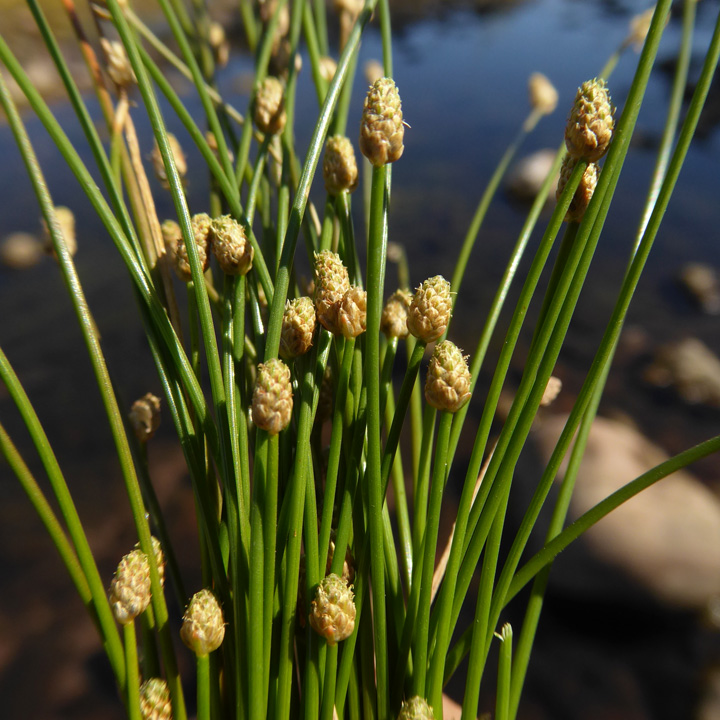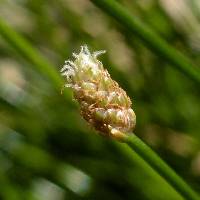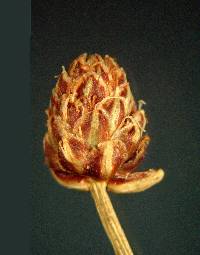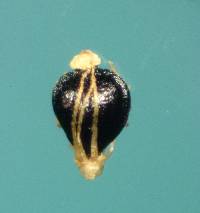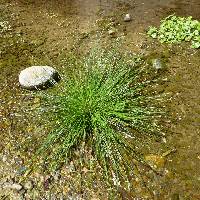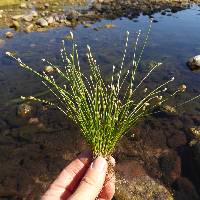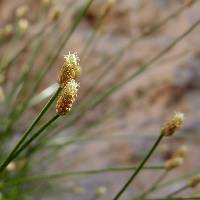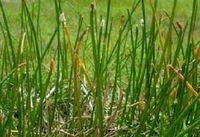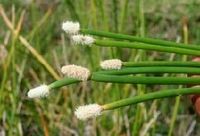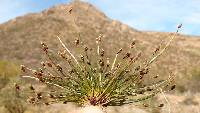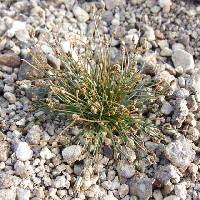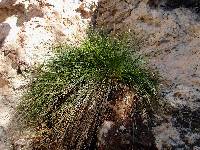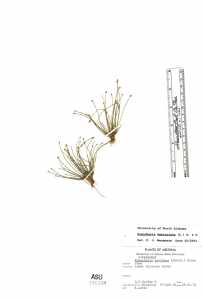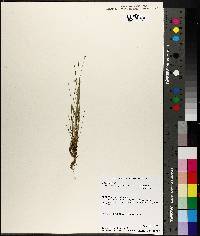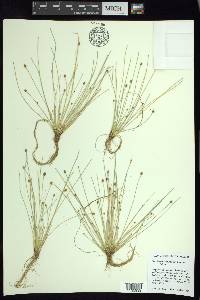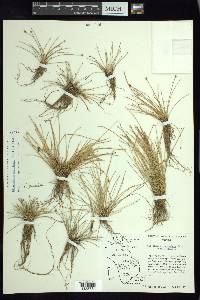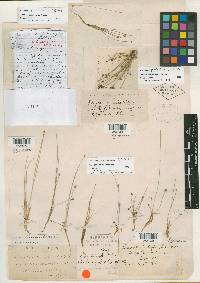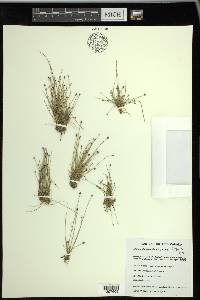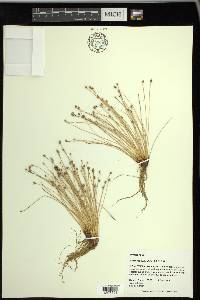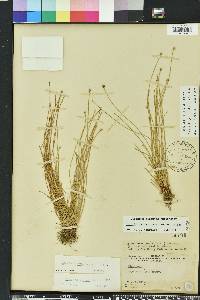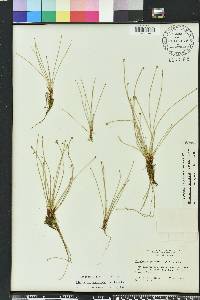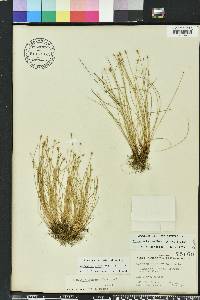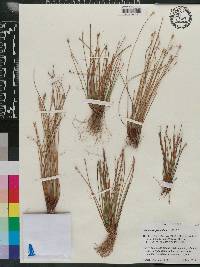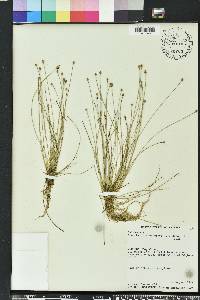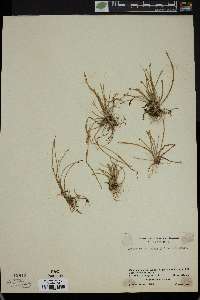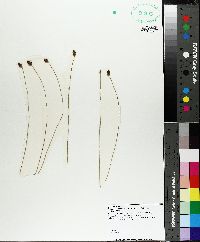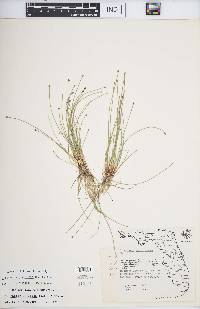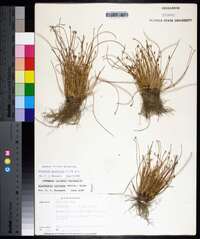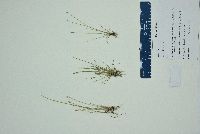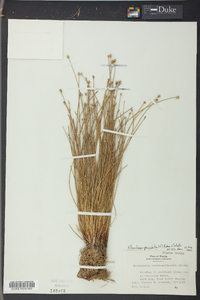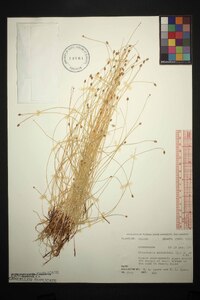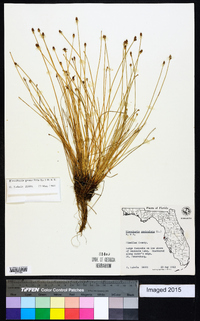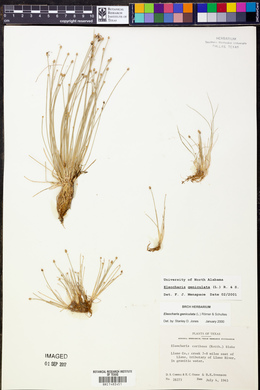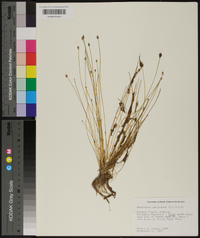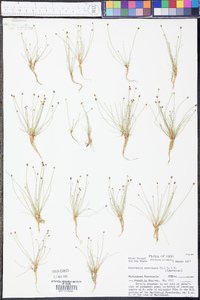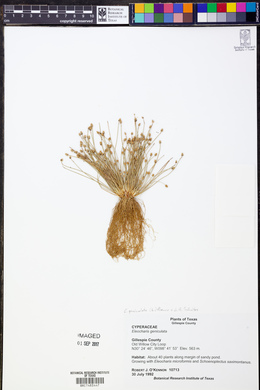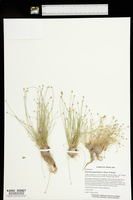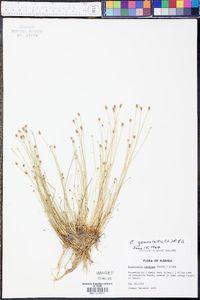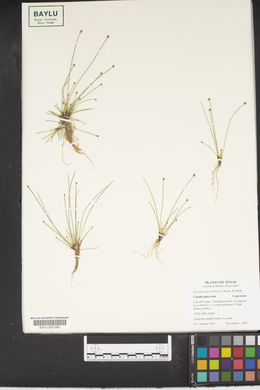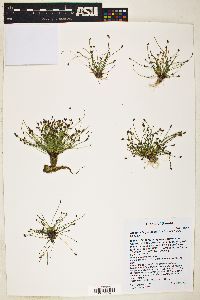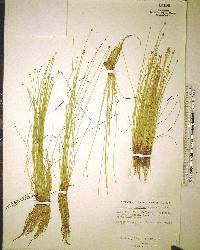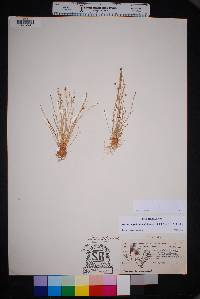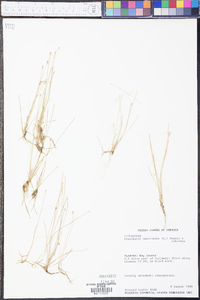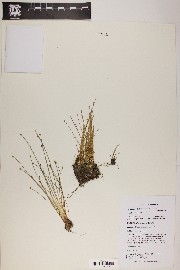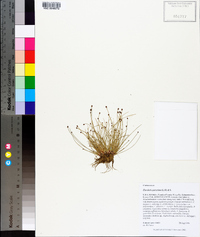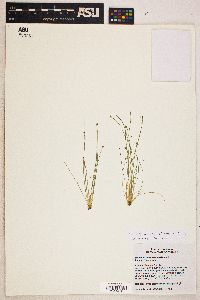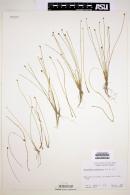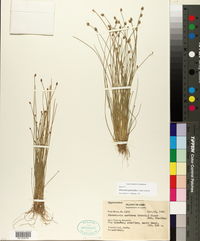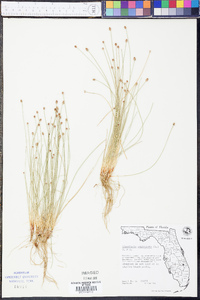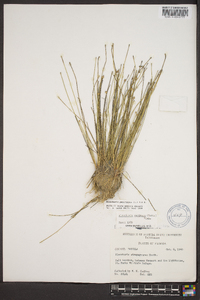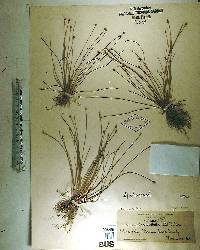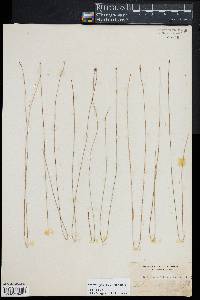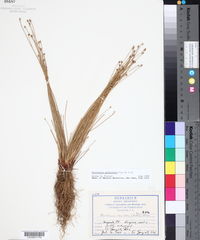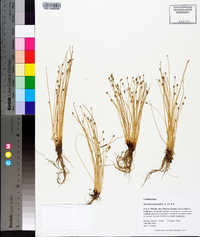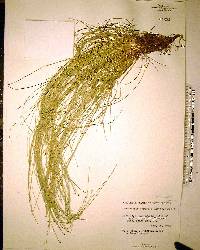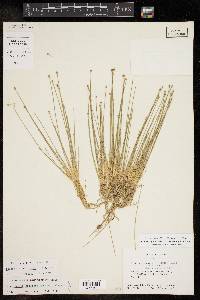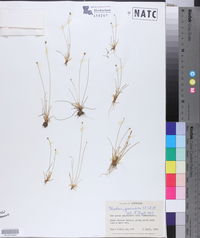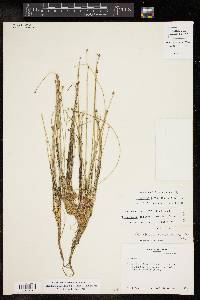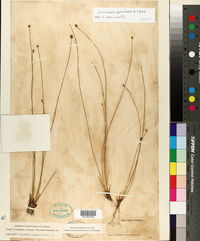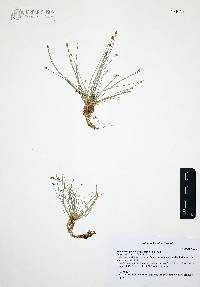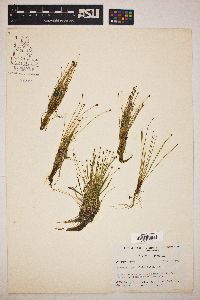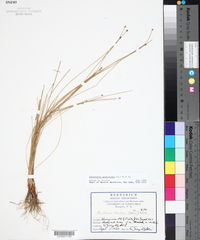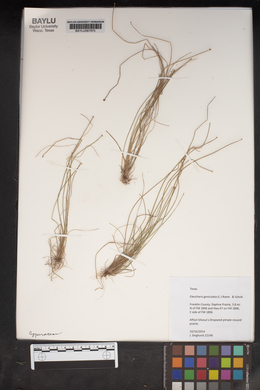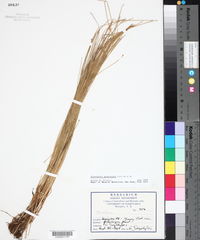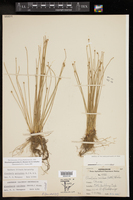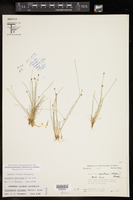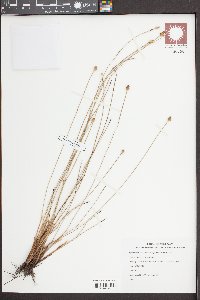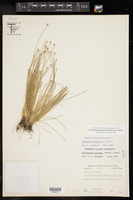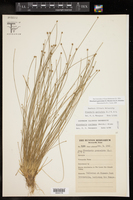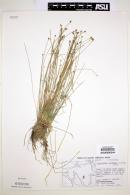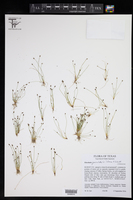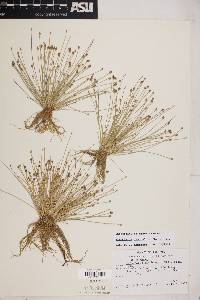
|
|
|
|
Family: Cyperaceae
Capitate Spike-Rush, more...Canada spikesedge
[Eleocharis capitata var. dispar (E.J. Hill) Fern., moreEleocharis capitata var. typica Svenson, not validly publ., Eleocharis caribaea (Rottb.) Blake, Eleocharis caribaea var. dispar (E.J. Hill) Blake, Eleocharis dispar , Scirpus caribaea Rottb., Scirpus caribaeus Rottb., Scirpus geniculata , Scirpus geniculatus L.] |
Plants tufted, without creeping rhizomes. Culms to 45 cm × 0.2-1 mm. Leaves: distal leaf sheaths persistent, firm, distally tightly sheathing, apex acute. Spikelets orbicular to ovoid, 1-9 × 1-4 mm, apex rounded to acute; proximal scale without flower, not amplexicaulous; floral scales to 125, 11-14 per mm of rachilla, tightly appressed, dark red-brown to stramineous, ovate to elliptic, 0.8-3 × 0.6-2(-2.3) mm, membranous to cartilaginous, apex rounded to acute. Flowers: perianth bristles (0-)4-8, typically 7, red-brown, rarely whitish, vestigial to much exceeding tubercle, typically equaling achene, spinules few to dense; styles 2-fid. Achenes brown ripening to black, biconvex, orbicular to obpyriform, 0.5-1.1 × 0.3-0.7 mm, apex rarely constricted proximal to tubercle, very finely reticulate at 40X. Tubercles stramineous to whitish, umbonate to subconic, 0.2-0.4 × 0.2-0.5 mm, apex rounded to acute. 2n = 10. Fruiting spring-winter (Mar-Dec). Brackish creeks, canal banks, dune depressions, hammocks, irrigation ditches, lakeshores, lagoons, mangrove thickets, maritime mud flats, ditches, salt marshes; 0-1500 m; Ont.; Ala., Ariz., Calif., Fla., Ga., Ill., Ind., La., Mich., Miss., Nebr., Nev., N.Mex., Ohio, Okla., Pa., Tex.; Mexico; West Indies; Bermuda; Central America; South America; Asia; Africa; Pacific Islands. The name Eleocharis caribaea (Rottbøll) S. F. Blake is considered by most contemporary authorities to be misapplied (K. L. Wilson 1990). Eleocharis geniculata has been reported from South Carolina; I have not seen a voucher.
Annual herb, tufted 3 cm - 45 cm tall Leaves: reduced to bladeless sheaths, basal, two per culm, margins fused and enclosing culm, pointed at the apex, and firm. Flowers: minute, spirally arranged on the axis of the spikelet, lacking sepals and petals, with zero to eight (usually seven) bristles, subtended by a scale. Bristles (when present) reddish brown, equal to or longer than achene. Stamens usually three, exserted. Anthers about 0.5 mm long. Pistil one. Style two-cleft. Fruit: a one-seeded achene, brown becoming black, 0.5 - 1 mm long, about 0.5 mm wide, spherical to reverse pear-shaped, lenticular (lens-shaped), finely wrinkled (at 40X). Tubercle straw-colored to whitish, to about 0.5 mm long and wide, with a rounded to pointed apex. Seed with a thin, non-adherent wall. Spikelets: solitary, 1 - 9 mm long, 1 - 4 mm wide, spherical to egg-shaped with a rounded to pointed apex, with up to 125 floral scales. Scales spirally arranged and overlapping, tightly appressed, straw-colored to dark reddish brown, 0.8 - 3 mm long, 0.6 - 2 mm wide, egg-shaped to elliptical with a rounded to pointed apex, membranous to cartilage-like. Culms: upright to widely spreading, unbranched, 3 cm - 45 cm long, to 1 mm wide, nearly circular in cross-section, enclosed basally by two fused sheaths. Similar species: No information at this time. Flowering: late July to late September Habitat and ecology: Rare in the Chicago Region, and currently known only from Lake and Porter counties in Indiana. Found on calcareous marsh borders. Occurence in the Chicago region: native Etymology: i>Eleocharis comes from the Greek words heleios, meaning "dwelling in a marsh," and charis, meaning grace. Geniculata means "sharply bent." Author: The Morton Arboretum FNA 2002 Common Name: Canada spikesedge Duration: Annual Nativity: Native Lifeform: Graminoid General: Tufted annual without rhizomes, stems to 45 cm, each 0.2-1 mm thick. Vegetative: Leaves with persistent sheaths above, firm, tightly sheathed at top with an acute apex. Inflorescence: Spikelets orbicular to ovoid, 1-9 mm by 1-4 mm, rounded to acute apex; upper scale without flower, not stem clasping, up to 125 floral scales, 11-14 per mm of rachilla, tightly appressed, dark red-brown to stramineous, ovate to elliptic, 1-3 mm by 0.5-2 mm, membranous, with rounded to acute apex; flowers with 4-8 perianth bristles, red-brown, rarely whitish, typically equaling achene, small spines few to dense, styles bifid; achenes brown ripening to black, biconvex, orbicular to obpyriform, 0.5-1 mm by 1 mm, finely reticulate under magnification. Ecology: Found along creeks, slack water, in depressions, along salt marshes, lagoons, and ditches from sea level to 5,000 ft (1524 m); flowers in April-November. Notes: As with most of these species, you need to get a collection to adequately assess its identity. The terminal spikes tend to be more ovoid than others in the genus. Ethnobotany: Unknown Etymology: Eleocharis is from Greek heleos or helos, a marsh, low ground, meadow and charis, grace, beauty, hence marsh grace, while geniculata means jointed or bent like a knee at a node. Synonyms: Eleocharis caribaea, E. capitata var. dispar, E. caribaea var. dispar, Scirpus caribaea Editor: SBuckley, 2010 Tufted annual; stems erect or divaricate, 3-20 cm, rarely more; sheaths firm, very oblique at the top; spikelet ovoid, 2-6 mm; scales numerous, round- ovate, obtuse; bristles brown, usually exceeding the achene, seldom shorter; anthers ca 0.5 mm; achene lenticular, black, shining, obovoid, 0.7-1 mm; tubercle pale, minute, very short. Pantropical, n. to S.C. and irregularly to Ont., Mich., and Ind. (E. capitata; E. geniculata, misapplied) Gleason, Henry A. & Cronquist, Arthur J. 1991. Manual of vascular plants of northeastern United States and adjacent Canada. lxxv + 910 pp. ©The New York Botanical Garden. All rights reserved. Used by permission. From Flora of Indiana (1940) by Charles C. Deam In wet, marl borders of lakes and in dried-up sloughs. In addition to the counties shown on the map, it is known in the Great Lakes area only from Washtenaw County, in southeastern Michigan and from southern Ontario. ...... Indiana Coefficient of Conservatism: C = 10 Wetland Indicator Status: FACW |
|
|
|
This project was made possible in part by the Institute of Museum and Library Services [MG-70-19-0057-19].
Powered by Symbiota

